| Jan-14-17 | | razetime: I thought so much, yet could not find the "quiet" move d5!! which frees the passed pawn on b4 and wins the game. The final position is absolutely unwinnable.
And this is a rapid game! Hikaru probably did all this in 5 minutes! |
|
| Jan-14-17 | | widjaja70: Rapid, rapid play or quick
Time controls for each player in a game of rapid chess are, according to FIDE, more than 10 minutes, but less than 60 minutes.[2] Rapid chess can be played with or without time increments for each move. In a game where time increments are used, a player can automatically gain, for instance, ten more seconds on the clock after each move. In a case where time increments are used, the total time per player for a 60 move game must be more than 10 minutes, but less than 60 minutes.[2] For the FIDE World Rapid Championship, each player will have 15 minutes, plus 10 seconds additional time per move starting from move 1.[5] The USCF quick chess rating for players is based on games with time controls per player greater than 10 minutes, up to a maximum of 65 minutes.[6] Games between 30 and 65 minutes per player are dual rated for both quick and regular ratings.[6] From 1987 to 1989 FIDE referred to rapid chess as active chess.[7] |
|
| Jan-14-17 | | nalinw: The idea of Bxh7+ and then a fork check with the Queen was used at least twice by White .... |
|
| Jan-14-17 | | YouRang: I pondered <23.Qe4>
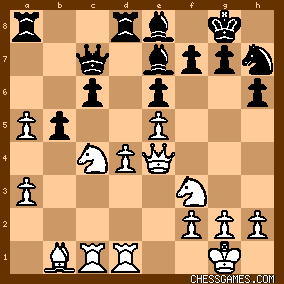
click for larger view
This threatens 24.Qxh7+! Kf8 Qh8#, but I figured that the chances tricking black with this tactic were too low to even mention. However, my efforts to find something better were disappointing, so I decided to go ahead and mention it. :-| |
|
| Jan-14-17 | | agb2002: White has a bishop and a knight for the bishop pair. Black threatens axb4.
The weak pawn on b6 suggests 23.d5, with the double threat d6 and Nxb6: A) 23... exd5 24.Nxd5
A.1) 24... Rb8 25.Nxd5
A.1.a) 25... Qb7 26.Nxe7+ Qxe7 27.bxa5 followed by Nd4 looks very good for White. A.1.b) 25... Qd7 26.Nf6+ and 27.Rxd7 + - [Q vs R+B]. A.1.c) 25... Rxd5 26.Rxd5 cxd5 27.Rxc7 wins.
A.2) 24... Ra7 25.Nxd5
A.2.a) 25... Qb7 26.Nxe7+ Qxe7 27.Rxd8 Qxd8 28.Qxa7 wins. A.2.b) 25... Qb8 26.Nxe7+ Rxe7 27.Qc5 looks good for White. For example, 27... Rxd1+ 28.Rxd1 Ra7 29.a6 Rxa6 (due to Bd3) 30.Qd3 (or 30.Bxh7+) with the double threat Qxh7+ and Qxa6 wins. A.2.c) 25... Rxd5 26.Rxd5 cxd5 27.Rxc7 Rxc7 28.bxa5 + - [Q+P vs R+B]. B) 23... cxd5 24.Nxb6 wins decisive material.
C) 23... Rxd5 24.Rxd5 followed by Nxb6 looks similar to the lines above. That's all I can do today. |
|
| Jan-14-17 | | AlicesKnight: I saw 25.d5 and some of the mate+pin threats but not enough to dare risk it.... |
|
| Jan-14-17 | | saturn2: The tricky thing in the game line is 26...RxN is answered by 27 Qe4 and this wins back the rook because of the double threat QxNh7++ |
|
| Jan-14-17 | | morfishine: Seen this one, powerful play |
|
| Jan-14-17 | | RandomVisitor: After 22...a5

click for larger viewKomodo-10.1-64bit:
<+1.21/42 23.d5 cxd5 24.Nxb6 Qb7 25.Nxa8 Rxa8> 26.Bc2 axb4 27.Rb1 Qc7 28.Rdc1 Qa5 29.axb4 Bxb4 30.Qd4 Be7 31.Ra1 Qd8 32.Rxa8 Qxa8 33.Bd3 Nf8 34.Rc7 Qa3 35.g3 Bd8 36.Rc8 Be7 37.Kg2 Bd7 38.Rc3 Qa5 39.Rc1 Qa3 40.Ra1 Qb4 41.h3 Qb7 42.Rc1 Qb8 43.h4 Ba3 44.Ra1 Be7 45.Qe3 Qc8 46.Rc1 Qb7 47.Nd4 |
|
| Jan-14-17 | | RandomVisitor: other choices, after 22.d5
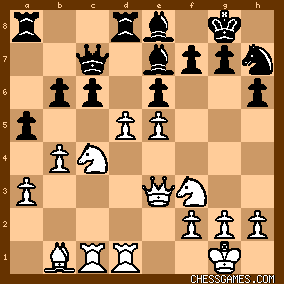
click for larger viewKomodo-10.1-64bit:
+1.68/32 23...exd5 24.Nxb6 axb4 25.Nxa8 Rxa8 26.axb4 Qb7 27.e6 Bxb4 28.exf7+ Qxf7 29.Ne5 Qf6 30.Qd4 Qd6 31.Bg6 Ba3 32.Bxh7+ Kxh7 33.Ra1 Kg8 34.Nc4 Qf8 35.Nxa3 Rxa3 36.Rxa3 Qxa3 37.Qe5 Bf7 38.h3 Kh7 39.Ra1 Qd3 40.Ra7 Qg6 41.Rc7 Be8 42.Kh2 Bf7 43.Qf4 Kg8 44.Rd7 Be8 45.Rd8 Qe6 46.Qd4 Qe1 47.g3 +2.20/32 23...Rxd5 24.Rxd5 exd5 25.Nxb6 Rd8 26.Nxd5 Rxd5 27.Qe4 Nf8 28.Qxd5 axb4 29.axb4 Bxb4 30.Qc4 Ba3 31.Rd1 Be7 32.Be4 Bd7 33.Nd4 Qxe5 34.Nxc6 Bxc6 35.Bxc6 Qf6 36.Bd5 g6 37.g3 Kg7 38.Kg2 Nd7 39.Qc6 Qf5 40.Be4 Ne5 41.Bxf5 Nxc6 42.Be4 Nb4 43.Rd7 Bc5 44.Rc7 Bb6 45.Rb7 +3.10/32 23...Bf8 24.d6 Qa7 25.Qxb6 axb4 26.Qxa7 Rxa7 27.axb4 Rb7 28.Nd4 Rxb4 29.Na5 Ra8 30.Naxc6 Rb6 31.Be4 Raa6 32.f4 g6 33.Ra1 g5 34.Rxa6 Rxa6 35.Nb8 Rxd6 36.exd6 Bxd6 37.Ndc6 Bxf4 38.Bxh7+ Kxh7 39.Rd8 Bxc6 40.Nxc6 Kg6 41.g3 Be3+ 42.Kg2 h5 43.Rd3 Bc1 44.Kf3 f5 45.Ne5+ Kf6 46.Nd7+ Ke7 47.Nc5 g4+ 48.Ke2 Kf6 |
|
| Jan-14-17 | | schachfuchs: Where is black's mistake earlier in the game?
Is 20....Nh7 the reason for all problems? Why not 20....Nd5 instead? |
|
Jan-14-17
 | | Jimfromprovidence: <saturn2> <The tricky thing in the game line is 26...RxN is answered by 27 Qe4 and this wins back the rook because of the double threat QxNh7++>. There's another trap set after 29 a6. Black avoids it. 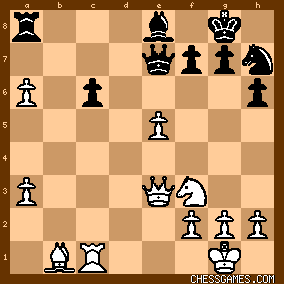
click for larger view If 29...Rxa6? 30 Bxh7+.
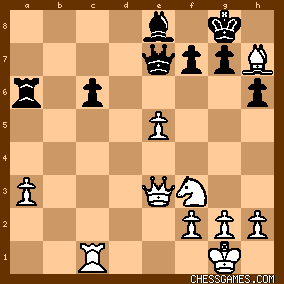
click for larger view This wins a piece as 30...Kxh7? allows 31 Qd3+. |
|
| Jan-14-17 | | RandomVisitor: After 8.Nbd2
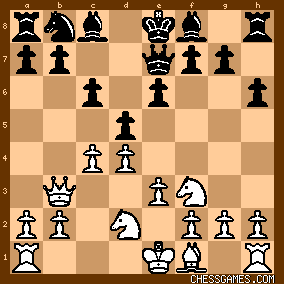
click for larger viewKomodo-10.1-64bit:
<+0.09/30 8...g6 9.Bd3 Bg7 10.0-0 Nd7 11.Rac1 0-0> 12.Rfe1 a5 13.Qc2 a4 14.a3 e5 15.cxd5 cxd5 16.e4 exd4 17.Qc7 dxe4 18.Nxe4 Qe6 19.Bc4 Qb6 20.Qg3 Kh7 21.h3 Nf6 22.Qd6 Nd7 23.Bxf7 Rxf7 24.Neg5+ hxg5 25.Nxg5+ Kg8 26.Nxf7 Kxf7 27.Re7+ Kg8 28.Rxd7 Qxd6 29.Rxd6 |
|
| Jan-14-17 | | RandomVisitor: After 20.e5 black is cramped whatever he does
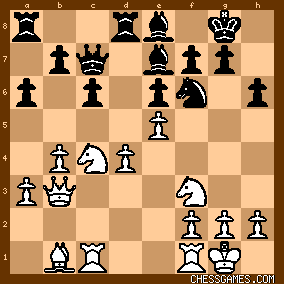
click for larger viewKomodo-10.1-64bit:
+0.53/30 20...Nd7 21.h4 b6 22.Be4 Rac8 23.Rfd1 Qa7 24.Qc3 Qb8 25.h5 Nf8 26.Rb1 Nd7 27.Re1 b5 28.Na5 Nb6 29.Rbc1 Nd5 30.Qb2 Kh8 31.Rc2 Kg8 32.g3 Qb6 33.Qc1 Bd7 34.Qd2 Qc7 35.Rec1 Qb6 +0.58/31 20...Nd5 21.h4 a5 22.Nxa5 f5 23.exf6 gxf6 24.g3 Bf8 25.Rfe1 Bf7 26.Nc4 Ne7 27.Kg2 Kh8 28.Qd3 Bg6 29.Qe2 Bf7 30.b5 Nd5 31.bxc6 bxc6 32.Qd3 Bg8 33.Qd2 Bf7 34.Nh2 Qa7 35.Re2 Rdb8 36.Bc2 c5 37.dxc5 Qxc5 38.Be4 |
|
| Jan-14-17 | | ChessHigherCat: I saw d5 right away with the idea of advancing to d6 or playing Nxb6 but I give myself zero points for the puzzle because I completely missed the main idea of 26 Nxd5 Rxd5, 27. Bxh7+ Kxh7, 28. Qe4+ K wherever and 29. Q*d5. That's an interesting tactic to maintain the threat of BxN to help with dirty tricks later on. |
|
| Jan-14-17 | | YouRang: <schachfuchs: Where is black's mistake earlier in the game?
Is 20....Nh7 the reason for all problems? Why not 20....Nd5 instead?> My engine wasn't so fond of black's immediately prior move, <22...a5>, where the eval jumped to about +1.12 (if 23.d5 cxd5). It recommended 22...Rab8 instead (with evals around +0.39). As for 20...Nh7, the engine thought it was okay:

click for larger view
Stockfish_16090917_x64_modern @ 33 ply:
+0.54 20...Nh7 21.Be4 b6 22.Rc2 Rac8 23.Qd3 Nf8
+0.59 20...Nd7 21.Na5 Nb6 22.h4 h5 23.Rfd1 Nd5
+0.68 20...Nd5 21.h4 h5 22.Ng5 Nf4 23.Qf3 Rxd4 |
|
| Jan-14-17 | | wtpy: Got to move 27..Rd5 and saw it woudnt work because of 28 Bh7+,so considered solved even though white is only pawn up. d5 is pretty easy to see as the natural break in the position but would I have seen over the board without knowing that there is a problem solution is, as always, a big question. Still 6\6 this week. |
|
| Jan-14-17 | | wtpy: Saturn2, I don't think 26.. Rd5 27 Qe4 works as well because of27.. Ng5. 28 Ng5 Bg5 and white no longer has a mate because the king can walk out at e7. Qd5 only picks up a pawn because black is hitting the white rook on c1 with his bishop. If white plays 28 Qd5 instead he only picks up the exchange rather than a whole rook though granted he should still win. Bh7+ followed by Qe4+ and Qd5 seems to be clearly better. Cheers |
|
| Jan-14-17 | | Cheapo by the Dozen: Like some, I saw the general idea of the queen fork, but not how to prepare it effectively |
|
| Jan-14-17 | | morfishine: <Cheapo> Its not that hard with a little training and practice ***** |
|
| Jan-14-17 | | ChessHigherCat: I think the idea of 20...Nh7 must be that he was planning to play Nf8 to defend the castle because the black king would be pretty lonely with the knight out on d5. White could start attacking immediately with 21. Qc2 or Qd3 and black would be forced to weaken the castle with g3. Then white could mobilize all his pieces quickly to attack and black would have difficulty defending, most of his pieces are on the wrong side of the board. |
|
| Jan-15-17 | | saturn2: <wtpy: Saturn2, I don't think 26.. Rd5 27 Qe4 works as well because of27.. Ng5. 28 Ng5 Bg5 and>hm i think after 27..Ng5 white has 28 QxRd5 the black pawn c6 being pinned which is the leitmotif of the whole puzzle. |
|
| Jan-15-17 | | schachfuchs: Thanks for your comments, <YouRang>! I always like your contributions (with diagrams at the critical points). |
|





































